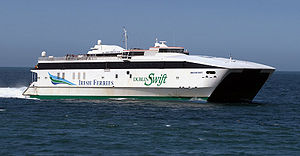HSC Jonathan Swift
 HSC Jonathan Swift crossing the Irish Sea | |
| Career | |
|---|---|
| Name: | HSC Jonathan Swift |
| Operator: | Irish Ferries |
| Port of registry: |
|
| Route: | Dublin-Holyhead |
| Builder: | Austal Ships, Australia |
| Cost: | IR£29 million |
| Yard number: | 94 |
| Launched: | February 1999 |
| Completed: | April 1999 |
| In service: | July 1999 |
| Identification: | IMO number: 9188881 |
| Status: | In service |
| General characteristics [1] | |
| Type: | High-speed catamaran |
| Tonnage: | 5,992 GT (gross tonnage) |
| Length: | 86.6 m (284 ft 1 in) |
| Beam: | 24.4 m (80 ft 1 in) |
| Draught: | 3.2 m (10 ft 6 in) |
| Installed power: | 4x Caterpillar 3618 diesel engines |
| Propulsion: | 4x Kamewa Waterjets |
| Capacity: |
800 passengers 200 cars |
HSC Jonathan Swift (aka Dublin Swift) is a high-speed ferry, currently owned and operated by Irish Ferries on their Dublin-Holyhead service. It is named after the Irish author Jonathan Swift.[2]
The vessel, a catamaran built by Austal Ships in Australia, was the first high-speed craft operated by Irish Ferries.[3] It entered service in July 1999.
Design and construction
Jonathan Swift was constructed by Austal Ships in Henderson, Australia,[1] at a cost IR£29 million.[4] The vessel was launced in February 1999 and was delivered to Dublin in May 1999,[2][1] before entering service in July 1997.[4]
The vessel is of a catamaran design.
Power is provided by four Caterpillar 3618 diesel engines with a total output of 28,800 kW. The vessel employs four Kamewa waterjets for propulsion.[2]
The Jonathan Swift was designed to allow quick turnarounds at port. It is equipped with a bow door which allows vehicles to drive on at either end and drive straight off at the end of the journey. The vessel was able to use existing terminal facilities in both ports.[2]
Onboard facilities
The vessel offers a number of catering facilities and seating areas. A "Club Class" lounge is available at an additional cost to the passenger which offers complimentary refreshments and reserved seating. Also available are shopping facilities and a video game arcade.[5]
Career
The introduction of the Jonathan Swift was delayed due to an industrial dispute between Irish Ferries and the trade union SIPTU, who represented seven officers that had been transferred from the company's conventional ferry operations to man the new high-speed ferry. These officers refused to operate the vessel at lower manning levels which had been proposed by Irish Ferries. Irish Ferries threatened to sell or charter the Jonathan Swift if the issue was not resolved.[4][6]
On its entry into service in July 1997, the Jonathan Swift increased Irish Ferries' passenger capacity on the Dublin-Holyhead route by 73%, and its car capacity by 50%. The vessel has spent its entire career on this route, operating alongside the company's conventional ferries.[3]
References
- ↑ 1.0 1.1 1.2 "Datasheet: Jonathan Swift" (pdf). Austal Ships. Archived from the original on 31 December 2009. http://www.webcitation.org/5mQBb318k. Retrieved 31 December 2009.
- ↑ 2.0 2.1 2.2 2.3 Wainwright, Dale (23 March 1999). "Irish Ferries newcomer". Lloyd's List (United Kingdom): p. 8. ISSN 0144-820X. http://www.lloydslist.com/ll/news/shipbuilding-and-marine-technology-irish-ferries-newcomer/20012534592.htm. Retrieved 31 December 2009. "Last month saw the launch of Irish Ferries' first fast ferry ... Named after the Irish author of Gulliver's Travels, Jonathan Swift, the vessel's principal particulars include an overall length of 86.6 m, waterline length of 74.2 m, moulded beam of 24 m and a draught of 3.2 m ... Powered by four Caterpillar 3618 diesel engines with a total generating output of 28,800 kW, the ship will have a service speed of 40 knots. Each of the main engines is linked to a Kamewa 112 SII waterjet via a Reintjes VLJ6831 gearbox ... The vehicle deck, with nine main deck lanes and six mezzanine deck lanes will be fitted with a bow door for drive through operation. Irish Ferries opted for this arrangement for driver convenience whilst reducing turnaround time in port. The new vessel will utilise existing terminal facilities.".
- ↑ 3.0 3.1 Wainwright, Dale (17 June 1999). "Irish Ferries joins the high-speed brigade". Lloyd's List (United Kingdom): p. 6. ISSN 0144-820X. http://www.lloydslist.com/ll/news/shipbuilding-passenger-shipping-nirish-ferries-joins-the-high-speed-brigade/20012538794.htm. Retrieved 31 December 2009. "Irish Ferries' planned introduction of a Dollars 40m high-speed ro-ro catamaran to its Dublin-Holyhead route represents its first venture into high-speed shipping ... Consequently, with the vessel operating alongside Irish Ferries' existing cruise ferry Isle of Inishmore, its capacity on the prime central corridor route between Dublin and Holyhead will increase to 15,200 passengers and 4,800 cars daily, or 73% and 50% respectively above existing levels.".
- ↑ 4.0 4.1 4.2 Mott, David (07 July 1999). Jonathan Swift starts service. United Kingdom. p. 16. ISSN 0144-820X. http://www.lloydslist.com/ll/news/jonathan-swift-starts-service/20012539887.htm. Retrieved 31 December 2009. "Irish Ferries' first fast ferry, Jonathan Swift, has started service after a three-week delay caused by an officers' manning dispute. The IPounds 29m (Dollars 38.6m) vessel is operating three round trips a day between Holyhead and Dublin. Irish Ferries had threatened to sell or charter out the vessel unless agreement was reached by last weekend.".
- ↑ "Our Ships: Dublin Swift". Irish Ferries. Archived from the original on 31 December 2009. http://www.webcitation.org/5mQD6v3Pb. Retrieved 31 December 2009.
- ↑ Mott, David (07 July 1999). End in sight for Irish Ferries dispute. United Kingdom. p. 3. ISSN 0144-820X. "Hopes were high last night that Irish Ferries' new IPounds 29m (Dollars 38.5m) fast craft Jonathan Swift will start service tomorrow after a three-week manning dispute ... Irish Ferries has threatened to abandon its plan to introduce the craft between the UK and Ireland if agreement is not reached. The dispute involves seven SITPU officers transferred from conventional ferries who refused to operate the new craft with lower manning levels agreed by a labour court.".
| ||||||||||||||||||||||||

